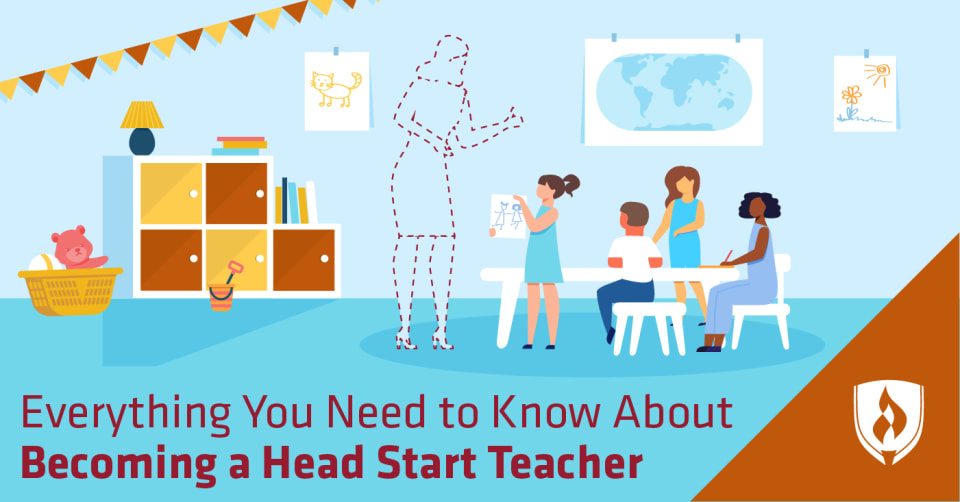
You thought you knew all the options for careers in early childhood education (ECE). You could work in a child care center, start your own home-based daycare or teach in a preschool or kindergarten.
But as you explored this career field, you came across one job title you weren’t too familiar with: Head Start teacher. What is a Head Start teacher, and how does this position compare to other ECE-related careers?
You have a lot of questions about this ECE role, and we have answers! Join us as we learn all about what it means to be a Head Start teacher from ECE professionals who have firsthand experience.
What is the Head Start program?
Head Start is a government-funded early childhood program that enrolls children from ages zero to five who are from low-income families. The Office of Head Start oversees 1,700 child care agencies across the nation, and they provide additional training for the teachers who work there.
Head Start programs offer a high-quality early learning environment for families who otherwise may not be able to afford child care. They use a play-based learning model to help children achieve their developmental milestones and prepare them for the school learning environment.
These programs aren’t just about teaching children, however. Head Start takes a broader approach to caring for children by also offering services that help connect families with affordable housing, health insurance and other resources. They also support children’s learning by providing nutritious meals that meet federal guidelines and screening children for developmental or learning delays.
Common duties of a Head Start teacher
Being a Head Start teacher is similar to teaching in other ECE programs in many ways. However, there are some key differences due to the high standard of quality Head Start programs are committed to providing families.
“More is required from the teachers in terms of observation and assessment tracking of the children,” says Diedra Boodoo, Assistant Professor for the Rasmussen University School of Education and former Head Start educator. “Teachers learn how to care for children with developmentally appropriate practices that must be adhered to within the program.”
Head Start teachers attend regular training meetings to ensure they’re using a developmentally appropriate practice. They also go the extra mile to make sure families are involved in their children’s education. Teachers may perform family home visits to engage with new families, invite families to visit the classroom and also encourage parents to complete In-Kind forms, which are a way of tracking parent volunteer hours that helps the Head Start Office provide additional funding to a program.
These are some of the common job duties a Head Start teacher can expect to encounter, according to Boodoo:
- Preparing outdoor play areas by clearing any debris and wiping down the play equipment
- Preparing the classroom by cleaning materials, books and tables
- Making and serving nutritious meals for breakfast, lunch and snack
- Welcoming children and parents and communicating with families about important information
- Joining children in activities and observing and documenting their skill development
- Practicing skill-building and goals with individual children
- Recording information about children’s development
- Attending classroom meetings and additional training
Students Head Start teachers work with
“All of the families who qualify for Head Start services live below the poverty level,” says Amelia Dalphonse, former Head Start teacher and co-owner of the non-profit autism resource Accessible ABA. This can bring additional challenges—the families you work with may not have reliable transportation or housing. These economic issues can make providing quality ECE more difficult, but Head Start teachers must be empathetic toward the families in their program, without bringing any prejudices, judgments or assumptions to their interactions.
“A Head Start teacher must not only accept diversity, he or she must embrace it,” Dalphonse says. “Often the families have experienced a variety of traumas, disabilities or addiction. All of the families are struggling in their own way and many are under extreme stress.”
Head Start teacher skills and characteristics
“[Head Start] teachers take on more responsibility in the classroom” than non-Head Start educators, according to Boodoo. This added responsibility, combined with diverse classrooms and the need to support families, means that Head Start teachers need certain characteristics and skillsets to succeed.
“A successful Head Start teacher is able to juggle a variety of responsibilities and obligations while managing their own stress,” Dalphonse adds. “A Head Start teacher must be more than just a strong teacher, he or she must see the big picture in which the child lives and be able to individualize their style for that child and family.”
Head Start teachers must also be willing to adapt their teaching style to meet the needs of children who have developmental delays or behavior challenges. “An understanding of how to address challenging behavior helps the Head Start teacher establish a sense of control in the classroom,” Dalphonse says.
“You cannot have a mentality of babysitting children to work in Head Start or Early Head Start programs,” Boodoo says. If you have these characteristics, you might have what it takes to be a Head Start teacher:
- Compassion
- Empathy
- Problem-solving skills
- Planning and organization skills
- Flexibility
- Active listening
- Eager to continue learning and improving
How to become a Head Start teacher
The Bureau of Labor Statistics (BLS) reports that center-based Head Start teachers require at least an associate’s degree.1 However, it may be in your best interest to consider a bachelor’s degree if becoming a Head Start teacher is on your radar.
“At least 50 percent of all preschool teachers in Head Start programs nationwide must have a bachelor’s degree in early childhood education or a related field,” according to the BLS.1 Boodoo adds that a bachelor’s degree is often required to be a lead teacher in a Head Start classroom.
After earning their degree, aspiring Head Start teachers will need some additional training, according to Boodoo. This may include the following:
- CPR/First Aid
- Medication administration training
- CLASS (Classroom Assessment Scoring System) assessment training
This training, along with continuing education to support best practices in child development, are typically provided by a Head Start center, but any training completed in advance could be a plus.
Giving kids a bright start
Being a Head Start teacher is truly about giving kids the best possible start to their education and development. If you want to join the ranks of these teachers who are making a big difference to little ones and their families, get started by learning about the educational options that can prepare you for a career as a Head Start teacher or other roles within early childhood education.
1Bureau of Labor Statistics, U.S. Department of Labor, Occupational Outlook Handbook, [accessed December, 2019] www.bls.gov/ooh/. Information represents national, averaged data for the occupations listed and includes workers at all levels of education and experience. This data does not represent starting salaries. Employment conditions in your area may vary.
Graduates of Early Childhood Education programs at Rasmussen University are not eligible for licensure as a teacher in an elementary or secondary school. A Bachelor’s degree and a state teaching license are typically required to work as a teacher in a public school and some private school settings. States, municipalities, districts or individual schools may have more stringent licensing requirements. Students must determine the licensure requirements in the state and school in which they intend to work.
Childcare facilities and the states in which they are located establish qualifications for staff who work with children, and often implement guidelines regarding age, education, experience and professional development. Students must determine the licensure requirements for the state and facilities in which they work.
This program has not been approved by any state professional licensing body, and this program is not intended to lead to any state-issued professional license. For further information on professional licensing requirements, please contact the appropriate board or agency in your state of residence.




